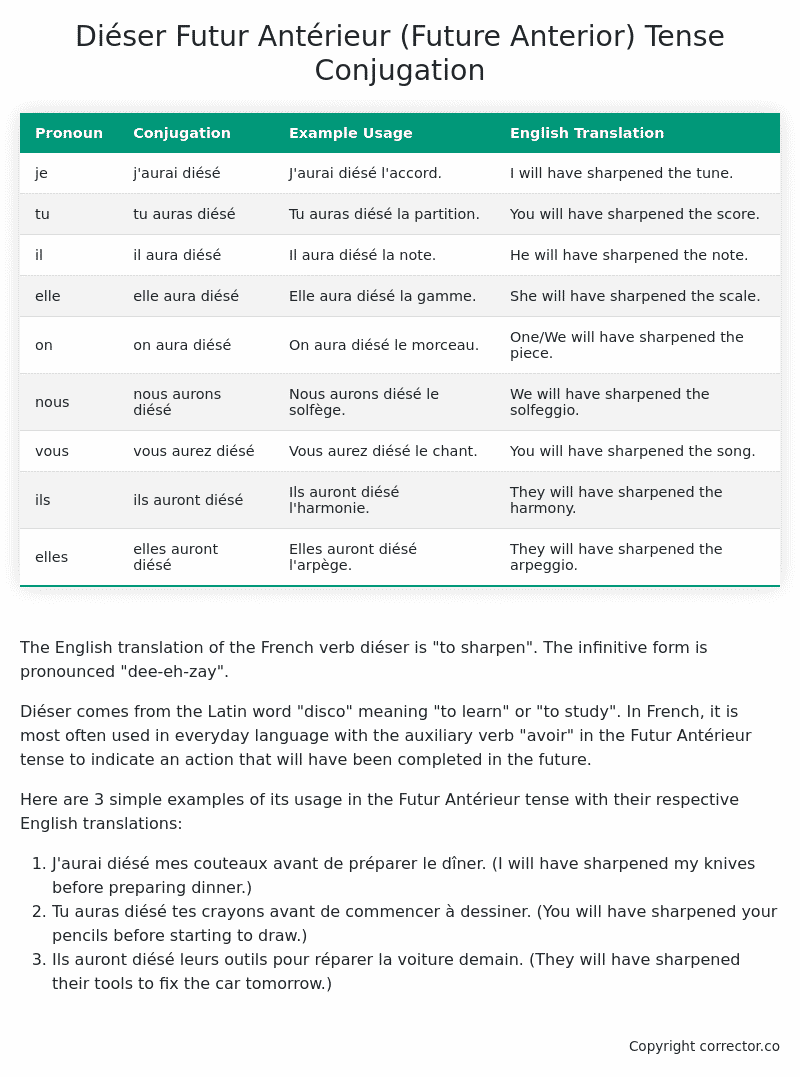Futur Antérieur (Future Anterior) Tense Conjugation of the French Verb diéser
Introduction to the verb diéser
The English translation of the French verb diéser is “to sharpen”. The infinitive form is pronounced “dee-eh-zay”.
Diéser comes from the Latin word “disco” meaning “to learn” or “to study”. In French, it is most often used in everyday language with the auxiliary verb “avoir” in the Futur Antérieur tense to indicate an action that will have been completed in the future.
Here are 3 simple examples of its usage in the Futur Antérieur tense with their respective English translations:
- J’aurai diésé mes couteaux avant de préparer le dîner. (I will have sharpened my knives before preparing dinner.)
- Tu auras diésé tes crayons avant de commencer à dessiner. (You will have sharpened your pencils before starting to draw.)
- Ils auront diésé leurs outils pour réparer la voiture demain. (They will have sharpened their tools to fix the car tomorrow.)
Table of the Futur Antérieur (Future Anterior) Tense Conjugation of diéser
| Pronoun | Conjugation | Example Usage | English Translation |
|---|---|---|---|
| je | j’aurai diésé | J’aurai diésé l’accord. | I will have sharpened the tune. |
| tu | tu auras diésé | Tu auras diésé la partition. | You will have sharpened the score. |
| il | il aura diésé | Il aura diésé la note. | He will have sharpened the note. |
| elle | elle aura diésé | Elle aura diésé la gamme. | She will have sharpened the scale. |
| on | on aura diésé | On aura diésé le morceau. | One/We will have sharpened the piece. |
| nous | nous aurons diésé | Nous aurons diésé le solfège. | We will have sharpened the solfeggio. |
| vous | vous aurez diésé | Vous aurez diésé le chant. | You will have sharpened the song. |
| ils | ils auront diésé | Ils auront diésé l’harmonie. | They will have sharpened the harmony. |
| elles | elles auront diésé | Elles auront diésé l’arpège. | They will have sharpened the arpeggio. |
Other Conjugations for Diéser.
Le Present (Present Tense) Conjugation of the French Verb diéser
Imparfait (Imperfect) Tense Conjugation of the French Verb diéser
Passé Simple (Simple Past) Tense Conjugation of the French Verb diéser
Passé Composé (Present Perfect) Tense Conjugation of the French Verb diéser
Futur Simple (Simple Future) Tense Conjugation of the French Verb diéser
Futur Proche (Near Future) Tense Conjugation of the French Verb diéser
Plus-que-parfait (Pluperfect) Tense Conjugation of the French Verb diéser
Passé Antérieur (Past Anterior) Tense Conjugation of the French Verb diéser
Futur Antérieur (Future Anterior) Tense Conjugation of the French Verb diéser (this article)
Subjonctif Présent (Subjunctive Present) Tense Conjugation of the French Verb diéser
Subjonctif Passé (Subjunctive Past) Tense Conjugation of the French Verb diéser
Subjonctif Imparfait (Subjunctive Imperfect) Tense Conjugation of the French Verb diéser
Subjonctif Plus-que-parfait (Subjunctive Pluperfect) Tense Conjugation of the French Verb diéser
Conditionnel Présent (Conditional Present) Tense Conjugation of the French Verb diéser
Conditionnel Passé (Conditional Past) Tense Conjugation of the French Verb diéser
L’impératif Présent (Imperative Present) Tense Conjugation of the French Verb diéser
L’infinitif Présent (Infinitive Present) Tense Conjugation of the French Verb diéser
Struggling with French verbs or the language in general? Why not use our free French Grammar Checker – no registration required!
Get a FREE Download Study Sheet of this Conjugation 🔥
Simply right click the image below, click “save image” and get your free reference for the diéser Futur Antérieur tense conjugation!

Diéser – About the French Futur Antérieur (Future Anterior) Tense
Construction
Common Everyday Usage Patterns
Interactions with Other Tenses
For example
Summary
I hope you enjoyed this article on the verb diéser. Still in a learning mood? Check out another TOTALLY random French verb conjugation!


